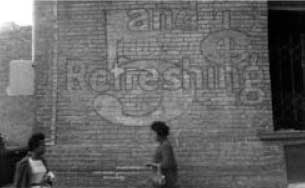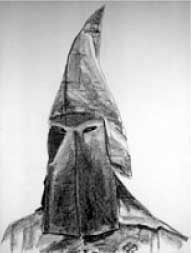RH: What is it about the passage of time that compels you to go back?
WC: It is like an unbelievable magnet. I can't wait to get out into that landscape and to go back and see those same places. Sometimes they are still there and sometimes they are completely gone.
RH: How does your re-photographing of sites affect your notion of time?
 |
 |
|
Wall, Marion, Alabama, "5 ¢ refreshing" (1964) © William Christenberry; Courtesy of Pace/MacGill Gallery
|
WC: Returning to the sites allows me to record both the traces of passing time and represent how a subject is transformed by time.
RH: What is the connection between the Palmist Building and your sense of time and mortality?
WC: I had known the Palmist Building all of my life. Originally it was a country store run by my great uncle Sydney Duncan, my grandmother's brother. It was on my father's bread truck route, in the 1940s. When Uncle Sydney retired and gave up the store, it was rented to gypsies who read palms and told fortunes. They hand-painted the sign, a palmist sign. [For a detailed account of the Palmist Building and other stories see Of Time & Place: Walker Evans and William Christenberry.] One day the landowner discovered the gypsies had skipped town and left the interior in shambles. He put the palmist sign in the window frame to keep the rain out. Inadvertently he stuck it in upside down, which made it more iconic for me than if it had been right side up.
RH: When did you start photographing the Palmist Building?
WC: The first Brownie picture was made in 1961 with black-and-white film. The first color picture, and probably the definitive view, was made in 1971.
RH: After years of effort you finally have the Palmist sign in your studio. Why was this important for you?
WC: It goes back to the act of possessing in the positive sense. It's all-encompassing. It's emotional, spiritual, and in an actual, physical sense sums up what I am about. I have lots of other beautiful hand-lettered signs that speak to me of Americana. For instance, I have forty-eight Top's Snuff signs alone. I have Coca-Cola signs, too. Whoever designed that script was a genius. It's a beautiful aesthetic form, which reminds me of exquisite single-stroke brush lettering.
RH: How did Walker Evans's sign collecting influence you?
WC: The signage in his photographs was an influence. We did occasionally engage in sign "liberation" episodes together, too. Once we were driving on a backcountry road in Alabama in 1973, and I saw this Top's Snuff sign on a fence post. Walker said, "I am going to have a hard time keeping up with old eagle-eyed Christenberry. Let's photograph it before you take it." I photographed him photographing the sign, but what he really wanted to see was the Palmist sign that was still in the window. I have pictures of him making a photograph of the Palmist sign. Walker was a great influence. We exchanged ideas until his death, and I like to think there was a lot of cross influencing. One of my choice found objects is a sign off the side of a building that Walker photographed in 1936 and is in Famous Men. I took the sign off the side of the building in 1966. He couldn't get over that. He had it included in his big show at Yale Art Gallery called "Walker Evans: 40 Years." I had a magnificent friendship with Walker. He was a wonderful man, a great artist, and I miss him.
RH: How is your work different from what Evans made in 1936?
WC: Unlike Agee, Walker kept his distance emotionally. His view was objective. My stance is very subjective. The place is so much a part of me. I can't escape it and have no desire to escape it. I continue to come to grips with it. I don't want my work to be thought of as maudlin or overly sentimental. It's not. It's a love affair - a lifetime of involvement with a place. The place is my muse.
RH: How does your southern sensibility regarding beauty affect your work?
 |
 |
|
Klan Drawing; © William Christenberry; Courtesy of Pace/MacGill Gallery
|
WC: Think of what Miss Emily Dickinson said, "Memory is a strange bell, jubilee and knell." I have a deep attachment to this haunted landscape, haunted in the sense that there is a dark side to it and there is a positive side. And a distance of about 800 miles from Washington, D.C., gives me a perspective of that place that I wouldn't have if I lived there day in and day out. By the time that I get to Tuscaloosa, I can't wait to get out into the countryside. It literally charges my batteries. I used to go out for a week or ten days and make three-hundred Brownie exposures. Now the film is almost impossible to get. When I work with the 8 x 10, I am not going to get 300 exposures. Last summer I made twenty 8 x 10 exposures. I still have access to some 127 and 620 Brownie Film and as long as I can get the film I am going to continue to make some Brownies. That 3 x 5-inch image is just a little jewel.
RH: How do you deal with the dark side of southern culture?
WC: Although my work is largely celebratory there is this dark side that permeates the South. How could I avoid the issues of the civil rights period and the terrible evil that manifests itself in the Ku Klux Klan (KKK)? I have often doubted whether or not I would live long enough to see the progress that the Deep South has made in civil rights, but there is still much to be done. Just a few weeks after my arrival in Memphis in 1962, James Meredith attempted to integrate the University of Mississippi, which is only sixty miles south of Memphis. In a way, Memphis is the big city of Mississippi. I was listening on the radio to the broadcast of that event. Two people were killed that night down in Oxford, Mississippi. How could I as a human being, forget being a Southerner, let that go by me? I've never been a marcher or a joiner, it's just not my nature, and sometimes I've regretted that. The only thing that I participated in along that line was the 1968 Memphis Sanitation Workers' March just before Dr. Martin Luther King Jr. was killed.
RH: Describe your first encounter with the KKK.
WC: In 1960, I read on the front page of the Tuscaloosa News about a Klan rally at the Tuscaloosa courthouse. I said to my friend Ed, "I'm curious. Let's check this out." He agreed to go. We got down there and there was no evidence of Klan activity outside. It was after dark, and the streetlights were on. There were not many people around. I suggested we go inside the courthouse. Ed said, "I'm Jewish, I'm not going inside." I gathered my courage and went in. The lights were blazing and yet nobody was around. I walked up these old marble steps to the second floor. Still nobody. I got to the top of the third level and just to my left was a Klansmen in full robe and hood. I had never seen an image like that before. This guard was standing at attention and there was a door to his left behind him. When I got to the top of the steps, he did not turn his head or his body. He turned his eyes to look at me. I have never seen anything more frightening than those eyes glaring through those eyehole slits. I stopped dead in my tracks and didn't go any further. I went right back down those steps and out of the building.
Continued on page 4